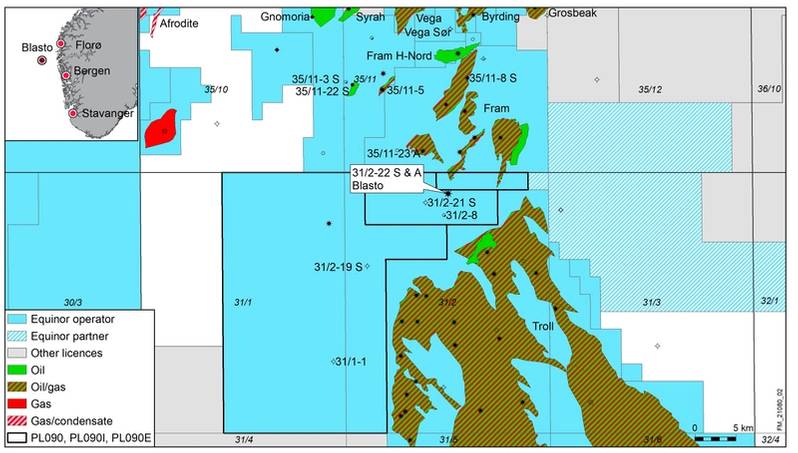
Norwegian oil firm Equinor, with its partners Vår Energi, Idemitsu Petroleum, and Neptune Energy, said Wednesday it had made the biggest discovery this year offshore Norway.
Preliminary estimates place the discovery size between 12 and 19 million standard cubic meters of recoverable oil equivalent, corresponding to 75-120 million barrels of recoverable oil equivalent, Equinor said.
Exploration wells 31/2-22 S and 31/2-22 A in the Blasto prospect of production licenses 090, 090 I, and 090 E were drilled using Seadrill's West Hercules semi-submersible drilling rig, some three kilometers southwest of the Fram field, 11 kilometers northwest of the Troll field and 120 kilometers northwest of Bergen.
“The discovery revitalizes one of the most mature areas on the NCS. With discoveries in four of four prospects in the Fram area during the past 18 months, we have proven volumes that in total will create considerable value for society,” says Nick Ashton, Equinor’s senior vice president for exploration in Norway.
Neptune Energy’s managing director in Norway, Odin Estensen said: “We are proud to be partnering with Equinor on such a significant discovery. Blasto is the first of two exploration wells we will drill in the Fram area this year, and fits with our strategy for exploration close to our existing infrastructure.
"These are important resources which can be brought into production quickly. It’s also a strategically important discovery for Neptune and underlines our commitment to continue growing our business in the Norwegian sector. In the last 15 months, we have participated in five exploration wells, and four of these have resulted in discoveries.”
 Credit: EquinorExploration well 31/2-22 S struck a total oil column of around 30 meters in the upper part of the Sognefjord formation and an oil column of around 50 meters in the lower part of the Sognefjord formation. The oil-water contacts were proven at 1860 and 1960 meters, respectively.
Credit: EquinorExploration well 31/2-22 S struck a total oil column of around 30 meters in the upper part of the Sognefjord formation and an oil column of around 50 meters in the lower part of the Sognefjord formation. The oil-water contacts were proven at 1860 and 1960 meters, respectively.
Exploration well 31/2-22 A struck high-quality sandstone in the Sognefjord formation, but the reservoir is filled with water, and the well is classified as dry, Equinor said.
Regarding the discovery to be commercially viable, the licensees will consider tying it to other discoveries and existing infrastructure in the area.
The wells were not formation tested, but extensive data acquisition and sampling have been carried out.
These are the first and second exploration wells in production licence 090 I. The licence was awarded in the 2017 awards in predefined areas (APA 2017) licensing round.
Well 31/2-22 S was drilled to a vertical depth of 2282 meters below sea level and a measured depth of 2379 meters below sea level. Well, 31/2-22 A was drilled to a vertical depth of 2035 meters below sea level and a measured depth of 2207 meters below sea level.
The water depth in the area is 349 meters. The wells have been permanently plugged and abandoned.
The West Hercules drilling rig will now move to drill exploration 34/6-5 S in production licence 554 in the northern North Sea sector.